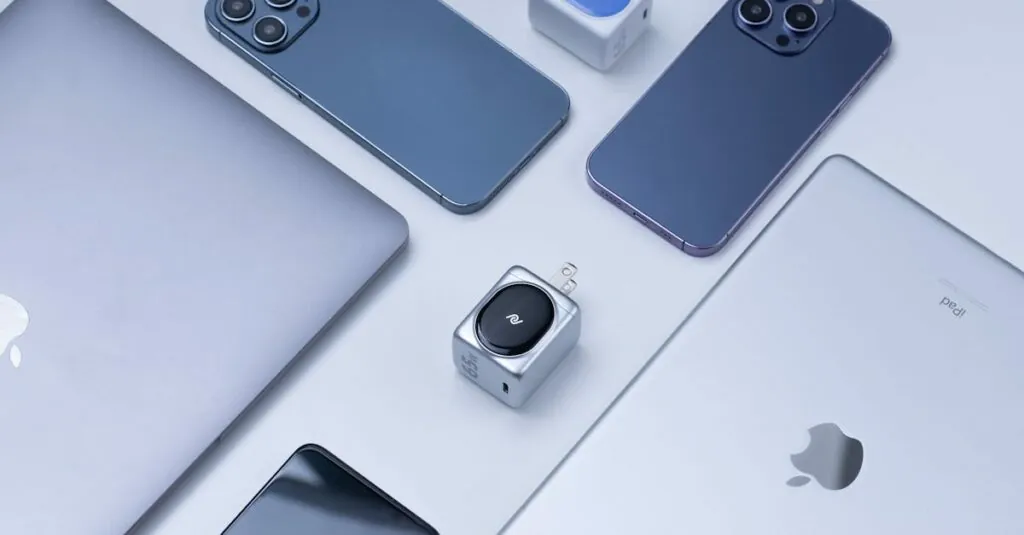Table of Contents
ToggleImagine this: you’re in a coffee shop, your iPhone’s battery is gasping for life, and your MacBook charger is just sitting there, looking all powerful and tempting. Can it really save the day? The good news is that charging an iPhone with a MacBook charger isn’t just a wild fantasy; it’s very much possible.
But before you start plugging things in like a mad scientist, there are a few things to consider. Not only could this charging combo be a game-changer for your on-the-go lifestyle, but it also raises some eyebrows about compatibility and safety. So, let’s dive into the electrifying world of chargers and find out if your MacBook can double as a superhero for your iPhone.
Overview of Charging Compatibility
Charging an iPhone with a MacBook charger is possible due to the similar charging protocols that both devices utilize. Apple designs its products to work together seamlessly, prioritizing convenience for users. A MacBook charger typically delivers higher wattages than standard iPhone chargers; however, this does not pose a risk to the iPhone. The device will only draw the specific power it requires, allowing for safe and efficient charging.
Many users appreciate the versatility this compatibility offers, especially when traveling. A single charger can serve multiple devices, reducing the number of chargers needed in a bag. Apple’s USB-C technology facilitates this connection, as newer iPhones come equipped with USB-C connectors, making the process even simpler.
Using a MacBook charger enhances charging speed for iPhones. While the standard charger for iPhones usually provides 20 watts, a MacBook charger may offer up to 61 watts or more. The increased wattage translates to faster charging times when the iPhone is connected, which is beneficial for those in a hurry.
Compatibility does vary slightly with older iPhone models. Devices prior to the iPhone 8 primarily used a USB-A connector, which requires an additional adapter to connect to a USB-C charger. Adapters convert the connection without compromising safety or charging efficiency.
It’s essential to avoid using non-Apple chargers or third-party chargers not certified by Apple. Inconsistent quality may lead to overheating or potential damage. Prioritizing safety ensures a longer lifespan for both the charger and the iPhone. Thus, understanding these compatibility nuances provides clarity for users considering this charging method.
Understanding iPhone and MacBook Chargers
Charging an iPhone with a MacBook charger is convenient, but knowledge of how these devices operate aids effective use. Both Apple products share similar charging protocols, which ensures compatibility and safety.
Differences in Power Output
Power output varies significantly between iPhone and MacBook chargers. iPhone chargers typically deliver 5 to 20 watts depending on the model. In contrast, MacBook chargers provide up to 61 watts or more. It’s crucial to note that the iPhone will only draw the necessary power it requires, which eliminates the risk of overpowering the device. Users experience faster charging when employing a MacBook charger, particularly beneficial in urgent situations where time is of the essence. The optimal efficiency ensures that charging remains safe and effective.
Connector Types
Connector types play a vital role in the charging process. Newer iPhones utilize USB-C connectors, which directly align with MacBook charging ports. This compatibility simplifies connections, allowing for straightforward charging without the need for additional accessories. Conversely, older iPhone models often use USB-A connectors. These models necessitate an adapter to link to a MacBook charger. Understanding these connector differences is essential for users aiming to utilize a MacBook charger for their iPhone effectively.
Benefits of Using a MacBook Charger for an iPhone
Using a MacBook charger for an iPhone offers several advantages. These benefits include faster charging times and convenience in using a single charger for multiple devices.
Faster Charging Times
MacBook chargers provide significantly higher wattage, enabling quicker charging for iPhones. An iPhone typically draws up to 20 watts via its standard charger, while MacBook chargers can deliver up to 61 watts. This increased power allows for rapid charging, making it beneficial for users needing battery boosts in a hurry. With the right charging cable, users can enjoy a full battery faster, alleviating downtime during busy days.
Convenience of Using One Charger
Carrying a single charger simplifies travel and reduces clutter. Users benefit from charging both iPhones and MacBooks without needing multiple chargers. This versatility also minimizes the risk of losing accessories while on the go. When compatible with USB-C connections, using a MacBook charger becomes straightforward, streamlining the charging process. The ease of having one charger eliminates the hassle of searching for the appropriate charger, streamlining the overall experience.
Potential Risks of Charging an iPhone with a MacBook Charger
Charging an iPhone with a MacBook charger can introduce some risks. Users should be aware of the potential for overheating and battery health implications.
Overheating Concerns
Overheating can occur when using a MacBook charger. Higher wattage doesn’t always equate to excessive heat, as devices typically manage power efficiently. However, prolonged use, particularly with intensive applications running, might elevate the device’s temperature. Additionally, using a worn-out or incompatible cable increases the risk of overheating. Always monitor the iPhone while charging, especially during extended periods.
Battery Health Implications
Battery health may also be affected by charging with a MacBook charger. Faster charging provides convenience but may stress the battery over time. Lithium-ion batteries exhibit longer lifespan with optimal charging practices. Using lower wattage chargers generally supports battery longevity. Regularly charging an iPhone with higher wattage could potentially shorten its battery life, so moderation is key for maintaining optimal battery health.
User Experiences and Recommendations
Many users find charging an iPhone with a MacBook charger convenient, particularly in situations where they need to power up quickly. Fast charging capabilities become a favorite feature among those who juggle multiple devices throughout the day. Users often report that their iPhones charge significantly faster using a MacBook charger due to its higher wattage compared to standard iPhone chargers.
Some travelers appreciate the ability to reduce the number of chargers they carry, allowing for a more streamlined travel experience. Newer models with USB-C connectors facilitate seamless connections that eliminate the need for additional accessories. Older iPhone models may require a compatible adapter, but users frequently mention that this minor inconvenience is worth the enhanced charging speed.
Users generally recommend being cautious regarding heat generation during charging. Overheating can occur if the charging cable is worn or not compatible with the devices. Many suggest monitoring the device’s temperature, especially when using it for intensive applications while charging.
Battery health also comes into play for regular users of MacBook chargers. Some note that while faster charging saves time, it might stress the battery over the long term. Users often advocate for moderation in employing higher wattage chargers to ensure their devices remain in optimal condition for years to come.
Overall, personal experiences reveal a preference for the practicality and efficiency of using a MacBook charger for iPhones. Recommendations often emphasize the value of understanding compatibility and watching for any signs of overheating, ensuring a safe charging experience.
Charging an iPhone with a MacBook charger offers a practical solution for those needing quick power boosts. Users can enjoy the benefits of faster charging times and the convenience of a single charger for multiple devices. While this method is generally safe due to Apple’s compatibility design, it’s essential to monitor the device’s temperature and use appropriate cables to avoid potential risks. Embracing this charging method can enhance efficiency for travelers and everyday users alike, making it a smart choice for anyone looking to simplify their charging routine.




